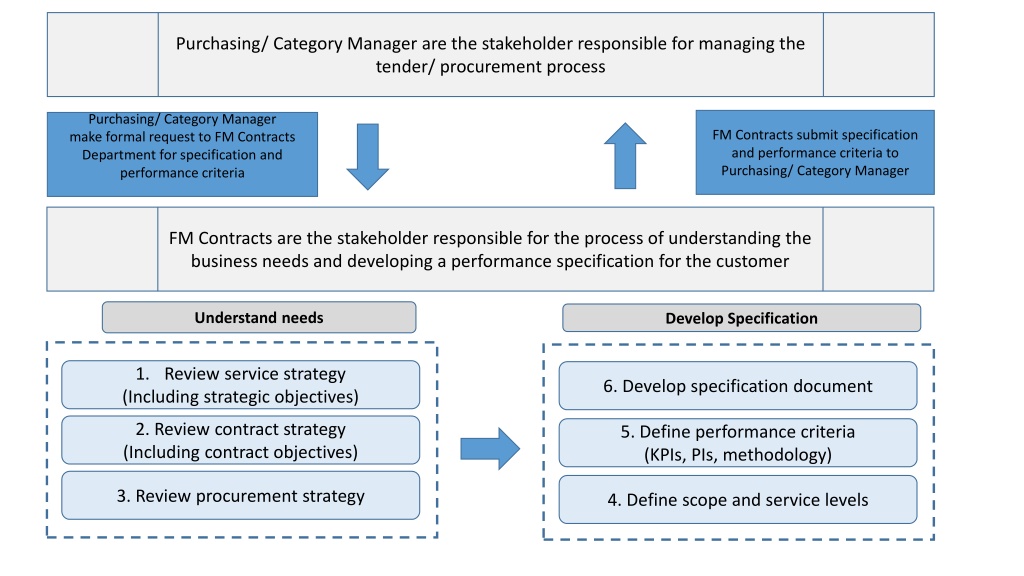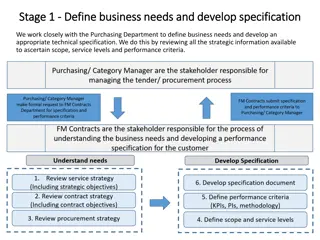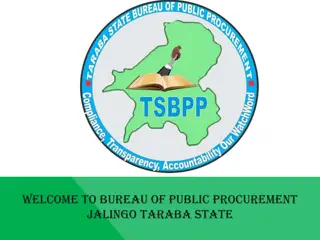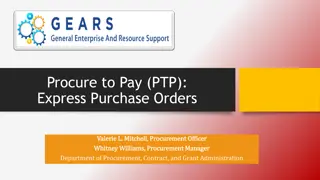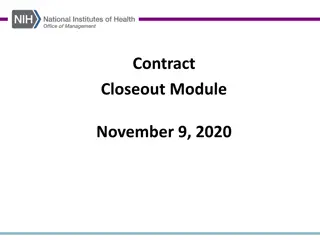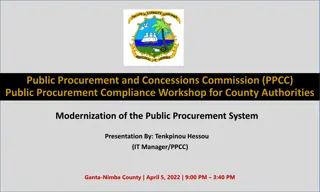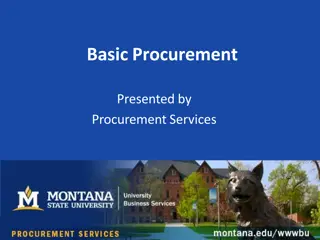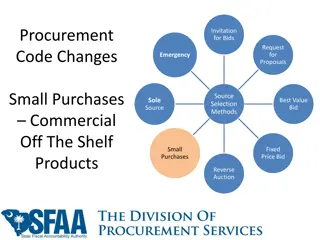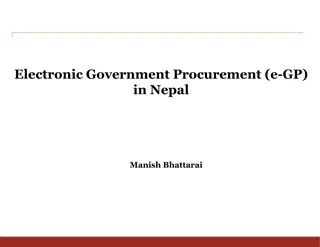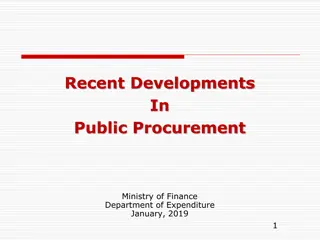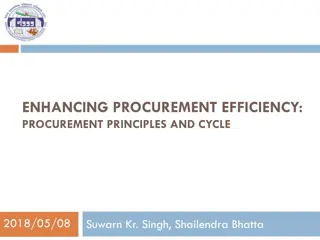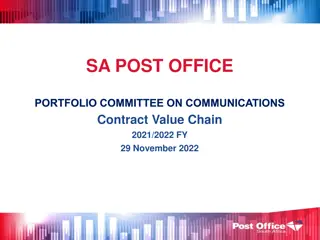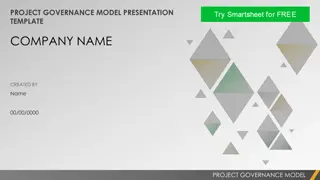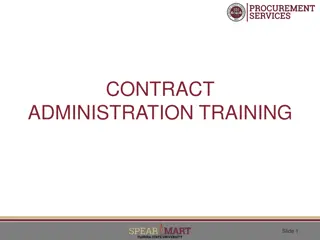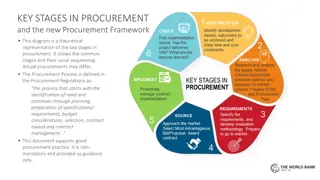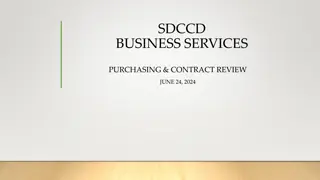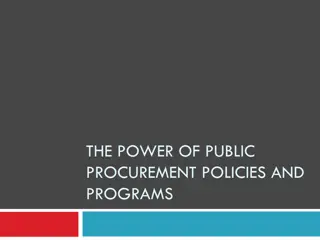Stakeholder Management and Contract Administration in Procurement Processes
Stakeholder management is crucial in procurement processes to ensure alignment with business needs and objectives. Purchasing/Category Managers and FM Contracts play key roles in understanding requirements, developing specifications, and managing contracts post-tender. By following a structured approach including stakeholder planning, contract administration, and ongoing review of stakeholder needs, organizations can enhance stakeholder satisfaction and optimize contract performance.
- Stakeholder Management
- Procurement Process
- Contract Administration
- Business Needs
- Stakeholder Satisfaction
Download Presentation

Please find below an Image/Link to download the presentation.
The content on the website is provided AS IS for your information and personal use only. It may not be sold, licensed, or shared on other websites without obtaining consent from the author. Download presentation by click this link. If you encounter any issues during the download, it is possible that the publisher has removed the file from their server.
E N D
Presentation Transcript
Purchasing/ Category Manager are the stakeholder responsible for managing the tender/ procurement process Purchasing/ Category Manager make formal request to FM Contracts Department for specification and performance criteria FM Contracts submit specification and performance criteria to Purchasing/ Category Manager FM Contracts are the stakeholder responsible for the process of understanding the business needs and developing a performance specification for the customer Understand needs Develop Specification 1. Review service strategy (Including strategic objectives) 6. Develop specification document 2. Review contract strategy (Including contract objectives) 5. Define performance criteria (KPIs, PIs, methodology) 3. Review procurement strategy 4. Define scope and service levels
Stakeholder Planning Stakeholder Analysis Develop RACI Matrix (Responsible, Accountable, Consulted and Informed). Identify stakeholders Develop Governance Structure University Administration & Services Academic Divisions & Departments Develop Communications Plan Accountable person[s] Define role and responsibility in the context of the contract Responsible person[s] Customers/ end users Committees/ working groups
Stage 3 Contract Administration Once the Purchasing Department has completed the tender process, we start to prepare the resources, processes and procedures to manage the contract once operational. It is important the specification work completed in Stage 1 is reflected in the terms and conditions of the contract. The work in this stage may inform the way we want the contractor to work and it s therefore important to communicate these requirements during the contract mobilisation and implementation phase. Planning Implementation Develop contract management processes and procedures Review terms and conditions Conduct gap analysis between terms and conditions and specification Develop/ revise/ propose contract clauses Define technological requirements Configure/ set up hardware/ software Stakeholder collaboration and communication Define human resource requirements Stakeholder management
Fundamental to a good relationship between stakeholders is the process of constantly reviewing the needs of stakeholders so that the contract can evolve over time to continually satisfy those needs. This stage relates to Oxford University stakeholders only and is not to be confused with supplier relationship management in stage 10. Stakeholder needs Stage 8 Management Resolution Stage 2 Stakeholder management Communication and evaluation Contract Development Process Stage 5: Performance management process People Technology Process Finance Equipment Service Realisation (Actual quality of service received) Resource Management Stakeholder satisfaction
Developing a suitable performance management regime to measure the key aspects of a contract is essential for stakeholders to understand how the contract is performing at any given point in time. This will help inform robust decision-making to change and evolve the contract and ensure the contract remains fit for purpose. Implementation Planning Develop performance management plan Monitoring Review Management reporting Review panel periodic meeting Collate performance data/ records Submit periodic management report Agree objective KPIs Agree performance management mechanism Identify performance trends Agree monitoring requirements Agree review process and review panel Agree management reporting mechanism Identify non- conformances/compliance and reasons why Agree scores and/or activate dispute resolution procedure Stage 8 Contract Development Process Periodic KPI inspection Agree dispute resolution procedure
Financial inputs Payment certification Services Provisional sums Capital Expenditure Contract terms and conditions Stakeholder roles and responsibilities Warranty terms and conditions Oxford University financial templates Oxford University financial procedures Provisional sum reconciliation Planon data and records Sub-contractor quotations, invoices and purchase orders Timesheets Work completion/ acceptance certificates Book keeping and receivables management Invoice submission Conformance with agreed payment period Manage aged debt Internal budget monitoring Project journaling Dispute management and resolution In conformance with contract and agreed financial procedures In conformance with agreed templates and information requirements
Planning Implementation Risk Assessment Risk Identification Risk Treatment Risk Monitoring Risk to contract objective Likelihood Avoid Record planning information in the Risk and Compliance Registers Risk from a scenario Impact Transfer Categorise risk Reduce Periodic monitoring and review Accept and control Periodic management reporting Roles and responsibilities Stage 2: Stakeholder
Contracts, particularly those long term (5 years or more), will need to evolve and develop over the term of the contract. This is inevitable to address the challenges of the day, whether they be internal in terms of stakeholder and business need, or external in terms of threats and legislative changes. Do Plan Identify the challenge or problem Conduct root cause analysis Develop implementation plan Stage 4: Relationship management process Implement plan Identify the opportunity Conduct cost-benefit analysis Act Check Stage 2: Stakeholder management process Governance/ Leadership Review Monitor performance Performance management Strategic direction Stage 7: Analyse results
process of continuous improvement. In the spirit of partnership and collaboration, our intent is to work closely with our suppliers to develop their capacity and capability to deliver a sustainable and successful contract. Do Plan Identify the challenge or problem Conduct root cause analysis Develop implementation plan Stage 4: Relationship management process Implement plan Identify the opportunity Conduct cost-benefit analysis Act Check Stage 2: Stakeholder management process Governance/ Leadership Review Monitor performance Strategic direction Stage 7: Analyse results management process Risk and Resilience process Management reporting
In the same way we must manage internal stakeholder needs in Stage 4, we must also be receptive to the needs of the supplier as a valued external stakeholder. We must be sympathetic to the issues and challenges they may be facing and consider recommendations for contract improvement Stakeholder needs Management Resolution Stage 2 Stakeholder management process Stage 9 Communication and evaluation Supplier Development Process Stage 5: Performance management process People Technology Process Finance Equipment Service Realisation (Actual quality of service received) Resource Management Stakeholder satisfaction
There are different reasons why a contract may be terminated; break clauses and poor performance are two examples. Whatever the reason it is essential that sufficient time and resources are assigned to the process. Demobilisation of the incumbent supplier and mobilisation of another poses various challenges and risk that must be carefully coordinated and managed. Planning Implementation Stage 3 Contract Administration Identify relevant clauses from the terms and conditions (E.g. Break clause or dispute resolution) Project Programmes Monitor project progress Communications Plan Stage 2 Stakeholder management Stakeholder communication Define and assign tasks and activities Risk Register Stage 5 Performance management Control and manage risk Lessons learnt/ continuous improvement initiatives Communications Plan Management reporting Incumbent supplier de- mobilisation programme Residual dispute management and
Stage 12 Asset Management At the end of a contract it is important to reconcile and account for assets owned by the University but previously managed by the supplier. The University will want to ensure its assets have been operated and maintained and any shortcomings in this regard recovered from the supplier. In the case of stock such as spare parts, an inventory and suitable storage should be available. Stage 5 Performance Management Stage 2 Stakeholder management Stage 7 Risk & Resilience Asset Identification Asset Performance Asset Planning Building Occupancy and utilisation Asset management plan Space Condition Life cycle replacement Plant/ systems Forward maintenance plan Maintenance
